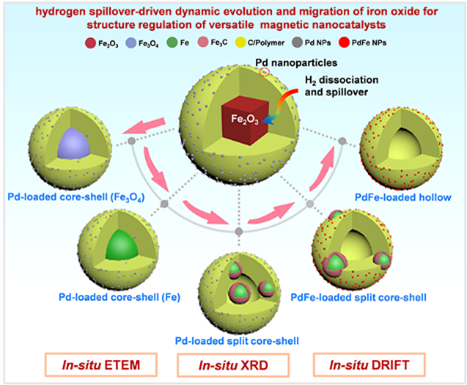祝贺张瑞平等同学的文章
“Hydrogen Spillover-Driven Dynamic Evolution and Migration of Iron Oxide for Structure Regulation of Versatile Magnetic Nano-catalysts”
被 J. Am. Chem. Soc. 接受发表!

Abstract
Magnetic nanocatalysts with properties of easy recovery, induced heating, or magnetic levitation play a crucial role in advancing intelligent techniques. Herein, we report a method for the synthesis of versatile core-shell-type magnetic nanocatalysts through “non-contact” hydrogen spillover-driven reduction and migration of iron oxide with the assistance of Pd. In situ analysis techniques were applied to visualize the dynamic evolution of the magnetic nanocatalysts. Pd facilitates the dissociation of hydrogen molecules into activated H*, which then spills and thus drives the iron oxide reduction, gradually outward split and migration through the carbonaceous shell. By controlling the evolution stage, nanocatalysts having diverse architectures including core-shell, split core-shell, or hollow type, each featuring Pd or PdFe loaded on the carbon shell, can be obtained. As a showcase, magnetic nanocatalyst (Pd-loaded split core-shell) can hydrogenate crotonaldehyde to butanal (26624 h-1 in TOF, ~100% selectivity), outperforming those reported Pd-based catalysts. This is due to the synergy of the enhanced local magnetothermal effect and the preferential adsorption of -C=C on Pd with small d bandwidth. Another catalyst (PdFe-loaded split core-shell) also delivers a robust performance in phenylacetylene semihydrogenation (100% conversion, 97.5% selectivity) as PdFe may inhibit the over-hydrogenation of -C=C. Importantly, not only Pd, other noble metals (e.g., Pt, Ru, and Au) also showed similar property, revealing a general rule that hydrogen spillover drives the dynamic reduction, splitting and migration of encapsulated nanosized iron oxide, resulting in diverse structures. This study would offer a structure-controllable fabrication of high-performance magnetic nanocatalysts for various applications.

